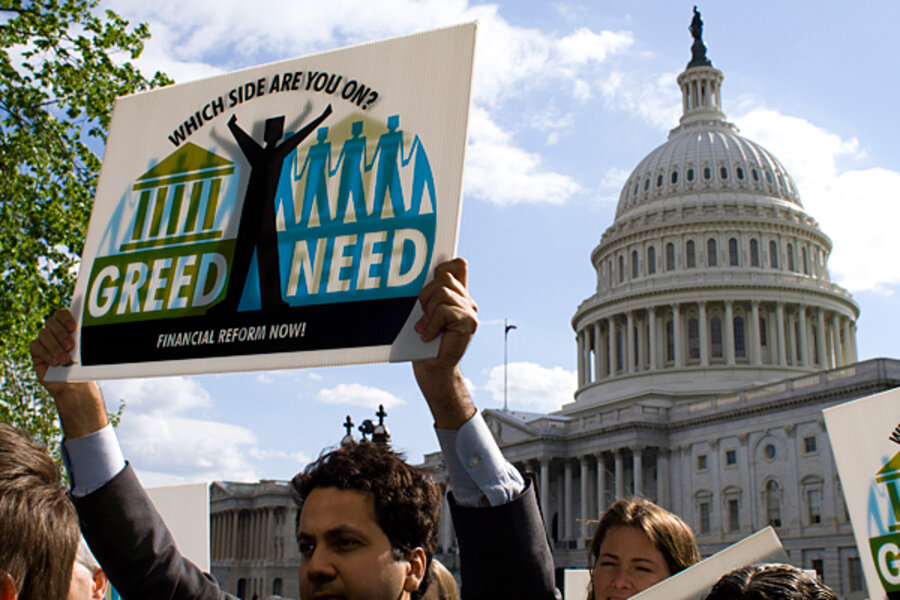Financial reform bill 101: what it means for consumers
Loading...
| Washington
The big financial reform bill now under consideration in the Senate is about more than collateralized back-flip derivatives and other stuff you have to be an MBA to understand. It could also affect how average Americans acquire credit cards, mortgages, bank accounts, and other ordinary features of modern monetary life.
Specifically, it would change who (or what) is supposed to protect you from being cheated when you sign up for complex financial products. Because after all, who really reads all the fine print that comes with credit card applications and mortgage loans?
Right now, a number of different government agencies regulate various kinds of consumer financial goods. Under the Senate bill as it stands at the beginning of the floor debate, a new Bureau of Consumer Financial Protection would unite these groups. Think of it as a cousin to the Department of Homeland Security, which was created by bundling together various existing US law enforcement organizations.
This new bureau would focus only on what’s good for consumers, and not on whether banks, say, are making enough money to stay in business. Its objectives would include ensuring the public gets timely and clear information, so you can make informed decisions about important financial moves; and protecting you from abusive or deceptive or discriminatory practices.
The Senate would make this new consumer bureau part of the Federal Reserve. The House version of the legislation sets it up as a completely independent agency, on the theory that this would allow it better to focus on its mission. But the Fed finances itself by its own activities, so tucking a Bureau of Consumer Financial Protection under its wing means the bureau won’t have to worry about Congress voting on its budget, among other things.
The Fed’s governors won’t be able to block or delay the new consumer bureau’s work, according to Senate legislative language. The "BCFP" would be run by an executive director, appointed by the president to a five-year term.
The bureau would maintain a toll-free number and a website to collect consumer complaints, according to the Senate bill. It would also have a staff to follow-up on complaints deemed serious.
It would have an Office of Financial Literacy, charged with developing a strategy to improve what US citizens know about the often-mystifying world of money.
But the heart of its work would be oversight of a host of existing Federal consumer financial laws, from the Electronic Fund Transfer Act, to the Fair Debt Collection Practices Act, to the Truth in Lending Act, to a string of laws related to mortgages and real estate settlement procedures.
The bureau would have broad leeway to write new rules and regulations implementing these laws. But it could exercise enforcement power only over big banks and credit unions with at least $10 billion in assets, as well as large nonbank financial companies, and most nonbank mortgage companies.
Some professions would be exempt from bureau scrutiny, per bill language. These include real estate agents, accountants, lawyers, and many retailers. But some Republicans complain that this new entity could wield too much power over small businesses that are simply extending credit to customers. They hope to make changes to the bureau’s powers via amendment during the upcoming floor debate.
However, remittance transfer providers – those stores and people who help immigrant workers send money back home – might face a crackdown of sorts. The bill would require these money changers to post daily signs showing how much local currency will end up in the hands of transfer recipients for each $100 and $200 sent from the US.
The importance that the authors of financial regulation legislation place on this new consumer bureau can be seen in the fact that the provisions dealing with it take up close to 25 percent of the entire 1,400 page bill. The legislation’s authors are trying to avoid a repeat of the hot years of the US housing bubble, when lenders were handing out sub-prime mortgages to people who could not afford them or did not understand them, setting up thousands to fall into the credit pit of foreclosure.
Related:
Editorial: The weak spot in the financial reform bill
Republicans relent, clear financial reform bill for debate
Financial reform: four sticking points
Financial reform bill 101: what it means for a new mortgage
Financial reform bill 101: what it might mean for your debit card





